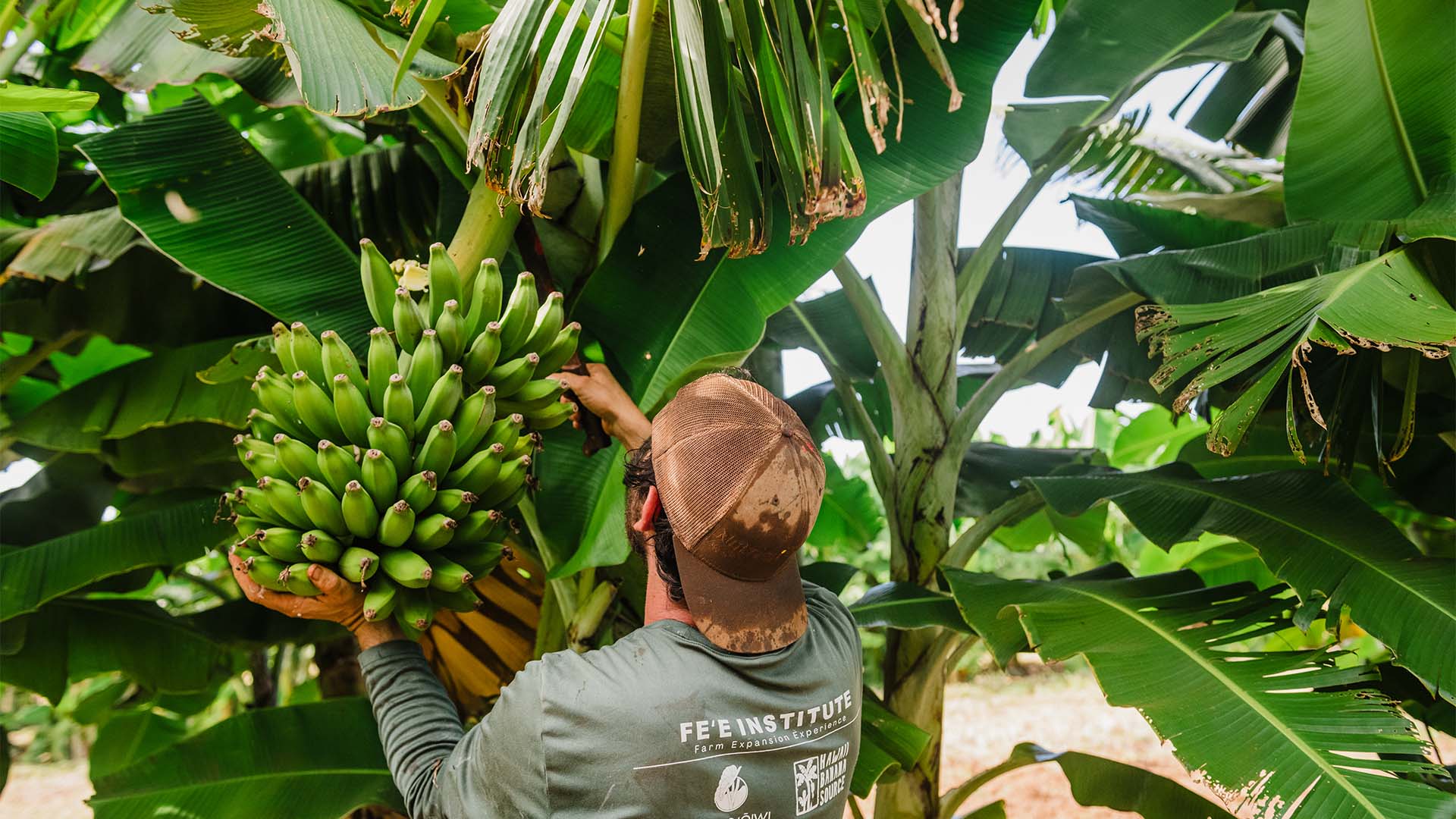From ATV eco-tours to experimental banana farms, many hands pitch in to restore and revive the abundance of the historic North Shore region.
Images by John Hook
Northbound on Route 803, the 5.9-mile stretch of rural highway leading folks from Wahiawa to the outskirts of the north shore, one is hit with this scenic vision: grand Mount Kaʻala kissing the highest clouds to the left, a breadth of farmland to the right; collectively their vastness recalls the creation story of Papahānaumoku and Wākea, the parent couple of the islands’ ruling chiefs and their abundant domain of fresh water springs, streams, fertile soil, and native plants.
This ʻāina momona is Waialua. A fertile land once rife with unceasing stretches of loʻi kalo and loko iʻa, Oʻahu’s most northern moku extends from coastal Kaʻena Point up into the Koʻolau Mountains and back down to Waimea Bay. This storied land, where ali‘i were birthed and then ruled until their departed spirits leapt into the sea, are eight ahupuaʻa: Kaʻena, Keālia, Kawaihāpai, two distinct acreages of Mokulēʻia, Kamananui, Paʻalaʻa, and Kawailoa. Today, without every islander sharing the kuleana of mālama ʻāina, like Native Hawaiian society traditionally mandated, entire fields, mountains, and waterways have become overrun with invasives. From up high one can see the extent of strawberry guava encroaching upon indigenous and endemic trees and plants.
Despite this, there are many committed folks chipping in to safeguard further degradation. Beyond the locked farm gates, homes, and businesses in and around Hale‘iwa Town, these farms and organizations make it their daily responsibility to be stewards of the land while offering something unique to a community fighting endlessly against more development.
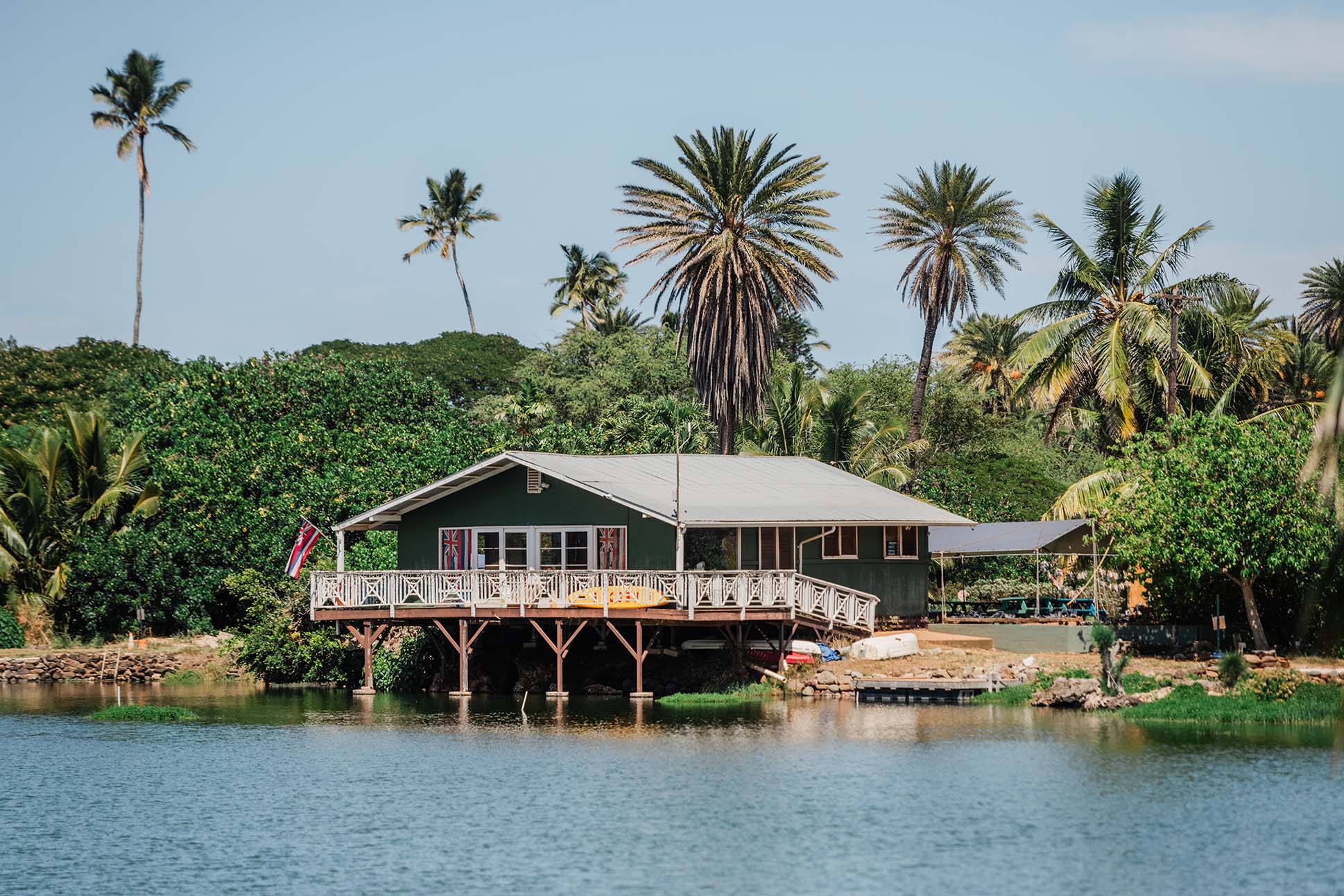
Waialua (wai, meaning “water,” and elua, meaning “two”) is possibly named after two of its largest streams: Anahulu stream and Kaukonahua stream.
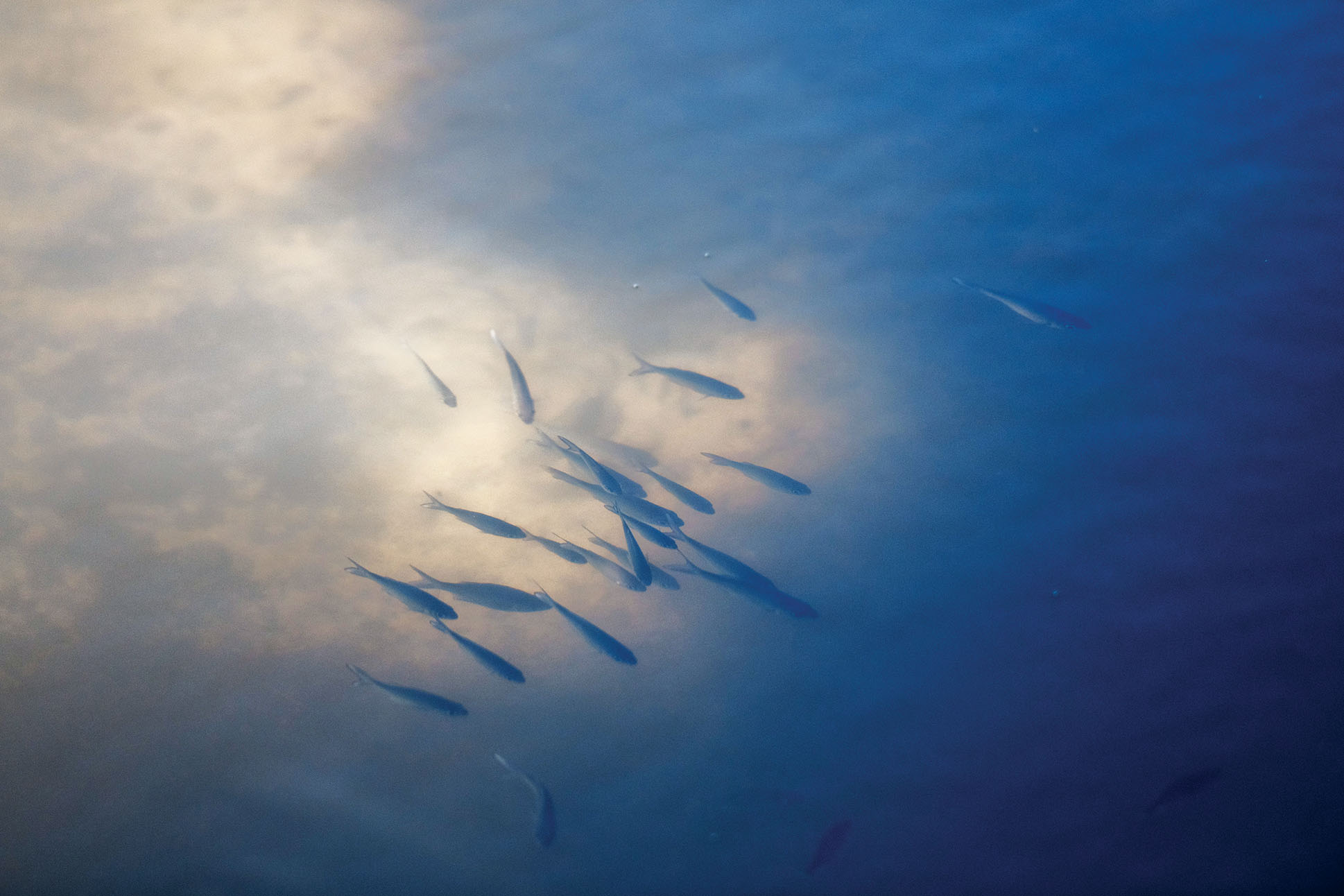
makai
Mālama Loko Ea Foundation
Tucked behind the surf shops and popular eateries on busy Kamehameha Highway in Hale‘iwa, the loko puʻuone, or sand dune fishponds, of Loko Ea and ‘Uko‘a quietly sit. The two have weathered centuries of wear from king tides to floods to modern-day development. Under the highway runs an ‘auwai kai that delivers fish from the ocean to these spring-fed ponds, which are connected by underground caves. The brackish water environment is home to pāpio, mullet, and ōholehole, which swim alongside native a‘ia‘i, endemic ducks, coconut trees, tī, and kalo. Tiny bubbles rising to the surface show the ponds’ bounty of phytoplankton creating oxygen and food for fish.
In 2007, the Waialua community asked landowners Kamehameha Schools if they could get back into these fishponds to restore them. When community work days began a year later, Kamehameha Schools eventually approached two dedicated volunteers, James Estores and Benson Lee, to start a nonprofit. One of the men, a heavy equipment operator, had the vision back then for the dredging being done now. Fifteen years later, Mālama Loko Ea is about a decade away from reaching its goal of reconnecting the ahupua’a of Kawailoa, meaning “the long water.” Working with traditional aquaculturist Buddy Keala, the nonprofit studies tides, cloud cover, and wind patterns everyday to understand how the loko pu‘uone operated precontact. After they are finished dredging Loko Ea the next step will be to reconnect it with its sister pond ‘Uko‘a, resulting in a 135-acre fully functioning fishpond that will produce an estimated 500 pounds of fish per acre every year. Each decision the nonprofit makes is carefully calculated to serve the community and Laniwahine, the kia‘i moʻo of this space.
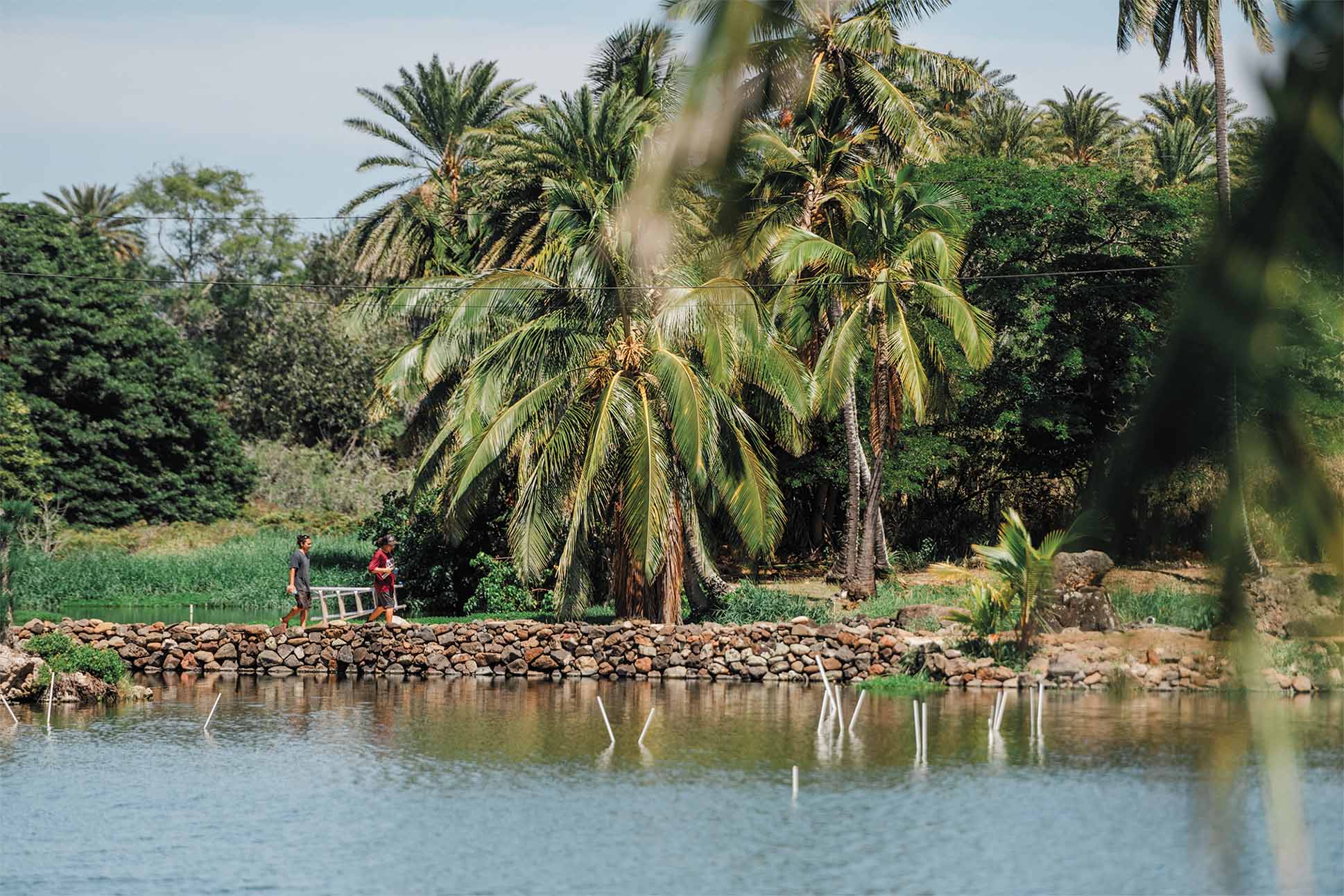
“We’re super mindful of our place and our responsibility and how it looks to our community,” executive director Rae DeCoito said. “We work hard for them.” Annually, Mālama Loko Ea hosts 400 community volunteer events and welcomes 80 schools, reaching over 9,000 students from Mākaha to Lā‘ie. One of the organization’s greatest strengths is instilling the values of mālama ʻāina in the next generation. Their climate education coordinator Honuʻāina Nichols is a perfect example. Fresh out of college, the 23-year-old is actively building a climate plan for Waialua and taking steps to make Loko Ea a resilience hub. “Our watersheds and wetlands are incredible at mitigating sea level rise, especially our kuapā,” Nichols said. Their favorite fact about how fishponds can combat climate change is that they are “carbon sequesters,” meaning loko i‘a not only provide food, but also reduce the amount of carbon dioxide in the atmosphere.
kula
Petal Mettle
Laarni Gedo’s Chevy pickup leads the way ahead a billowing cloud of red dust. We arrive at a dirt road dividing 35 acres into two parcels: one for flowers, one for bananas. Gedo sits near her mother, Norma, who is taking a short break. “She’s a workhorse,” Gedo said. “She’s here four to five hours every day. Then she goes home and works in her own garden.” The two women operate Petal Mettle, an organic farm that Gedo designed while she was caring for her dying father. “Growing flowers really connected me to the natural cycle of life,” she said.
In the garden ornamental kale sprawls across the soil like an octopus searching for prey, while an ‘aʻaliʻi shrub stands unbothered blocking the wind. There are rows of fuzzy, coral-like celosias in pink, white and magenta; dahlias in deep reds and purples; marigolds the color of autumn leaves; and multiple species of spiny amaranth ranging from crimson to burgundy. Not the tropical flowers that Hawaiʻi florists typically carry, Gedo’s harvest aims to offer something different: blooms just as beautiful, but also medicinal and edible. Beyond bouquets, Gedo sells tiny blossoms to chefs for garnishes and makes wellness products including a buzz button tincture for dental hygiene and a facial toner made of witch hazel, butterfly pea flower, and sage.
Gedo appreciates the relaxed pace of Waialua compared to town where she lived when she moved to O’ahu in 1992. Originally from the Philippines, Gedo and her parents moved to California in 1990, before continuing to Oʻahu. When her military father got assigned to return to California, Gedo stayed put. When her father passed, Norma returned to O‘ahu. Gedo runs the farm and floral business, making deliveries, bouquets and wellness products, while Norma, a lifelong farmer, performs the neverending task of pulling weeds. “She is employee of the month every month,” Gedo said.
Cafes, florists, event companies, and hobbyists make up the bulk of her business in Waialua. Sometimes a barter system prevails for this tight-knit community. During the pandemic, the owner of Haleiwa Bowls doubled his order of edible flowers when the owner learned business had slowed. A mile away at Wicked Hi Cafe, Gedo places a bucket of bouquets near the register with a QR Code. If a customer is inspired to buy, they choose what they like and pay via Venmo. In exchange the cafe gets a bouquet of their own. Usually something wild, sprawling and brimming with otherworldly shapes and textures.
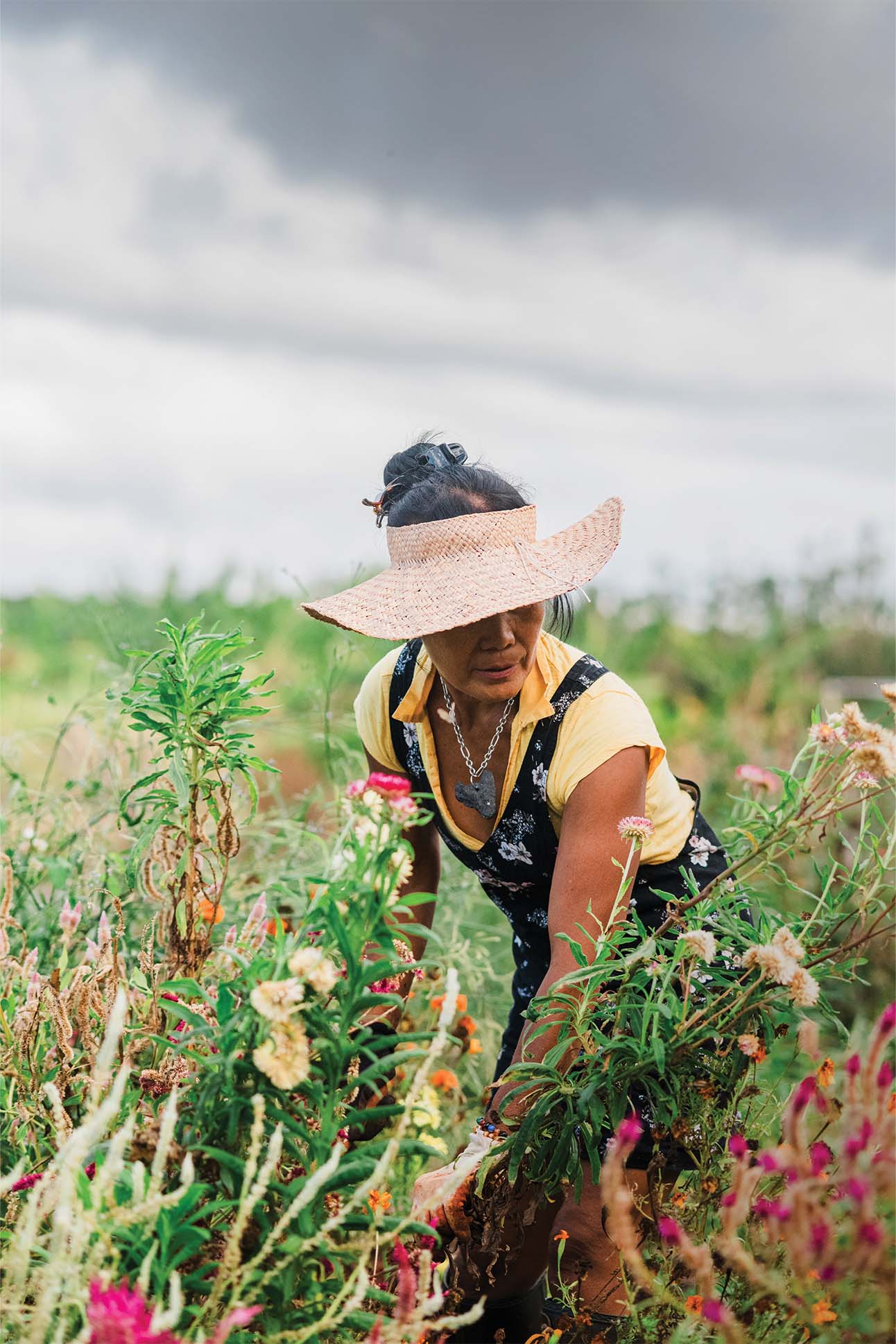
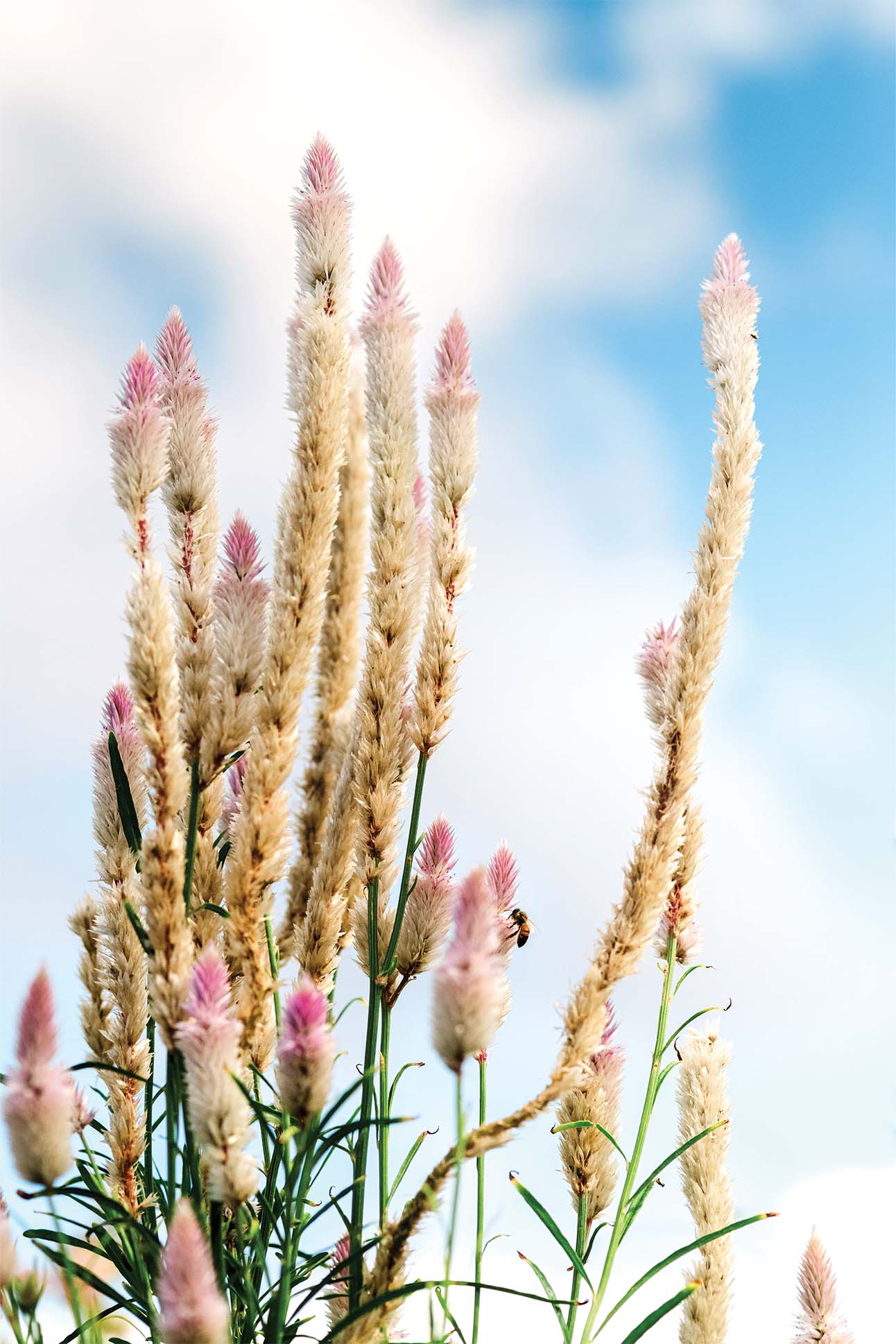
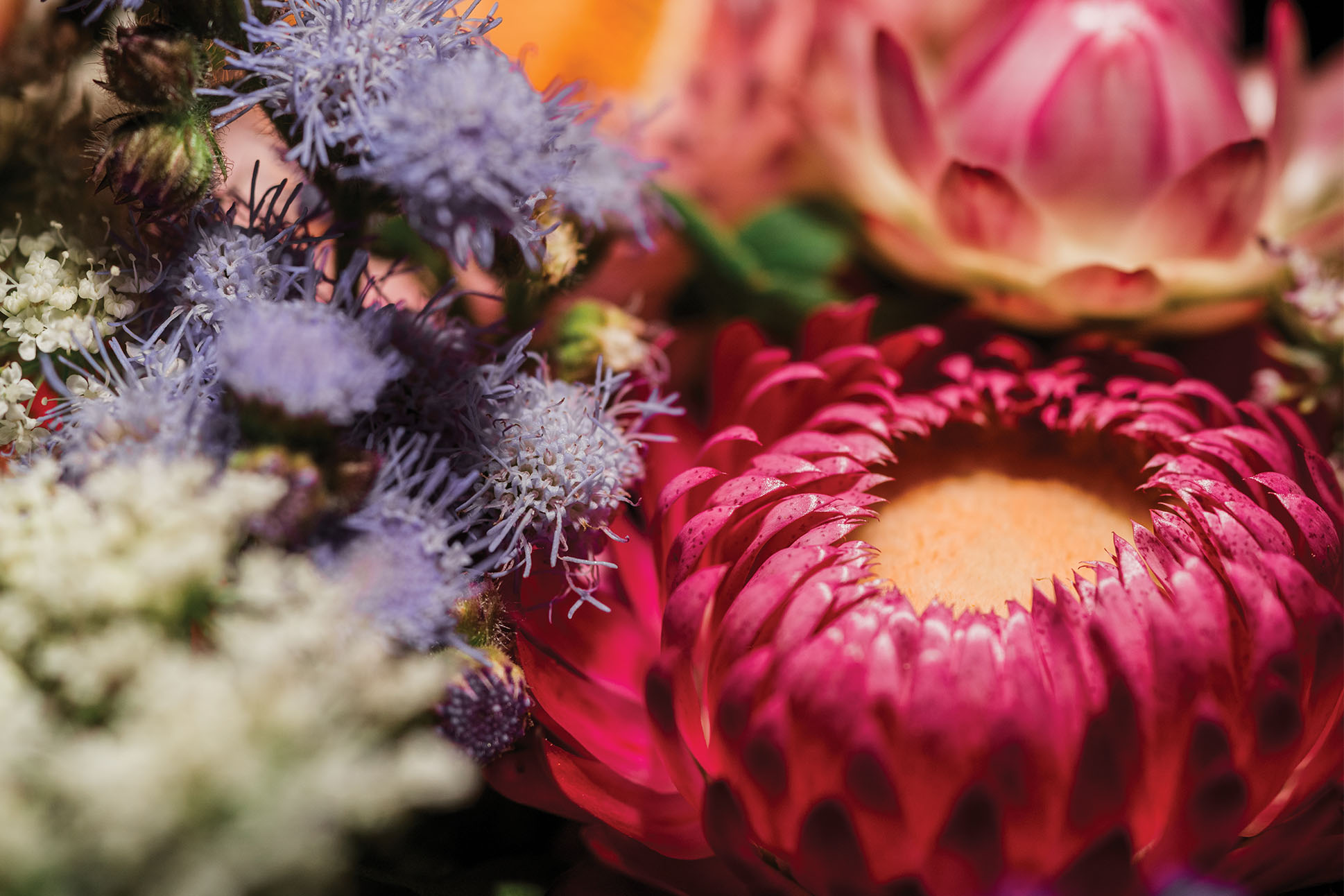
“We’re super mindful of our place and our responsibility and how it looks to our community,” said Rae Decoito, mālama Loko ea Foundation Executive Director. “We work hard for them.”
On the same parcel as Petal Mettle, Gabriel Sachter-Smith grows organic bananas for Hawaiʻi Banana Source. While this is considered his production farm, his processing facility, nursery and breeding field are all located on the other side of Weed Circle in Haleiwa Town. Both Petal Mettle and Hawaiʻi Banana Source sprouted from a farm that Rob Barreca, who founded Farm Link, began after winning the Mahiʻai Match-Up award in 2015. Sachter-Smith came on to help manage Barreca’s farm with the agreement that it would one day become a banana enterprise.
For distribution, Sachter-Smith mostly grows apple, namwah, and Gros Michel varieties, with the intention of scaling up saba and iholena. He also gives neighboring organizations such as Kōkua Learning Farm and Mālama Loko Ea starters of Hawaiian bananas for cultural education at the annual Banana Festival in Waimea Valley where novice gardeners get underway with their first plants. Sachter-Smith has grown bananas since he was 14 years old in Colorado. After studying tropical plant and soil science at the University of Hawaiʻi, he earned his masters studying banana bunchy top virus in Washington. He now travels the world as an expert in his field.
There are about 150 varieties of bananas on the farm, including 12 Hawaiian varieties. One of Sachter-Smith’s biggest goals is to see the iholena variety gain in popularity. Iholena, a cooking banana whose Hawaiian name means “yellow-orange core,” gets its salmon hue from high levels of carotenoids. He is working with popular farms such as, MAʻO Organic Farms, Kualoa Ranch and Hawaiʻi ʻUlu Cooperative to introduce iholena to their markets so that more locals get to enjoy this island delicacy. “They check all the boxes,” Sachter-Smith said. “They’re culturally relevant, a staple food crop, really nutritious, canoe crop, who doesn’t want that?”

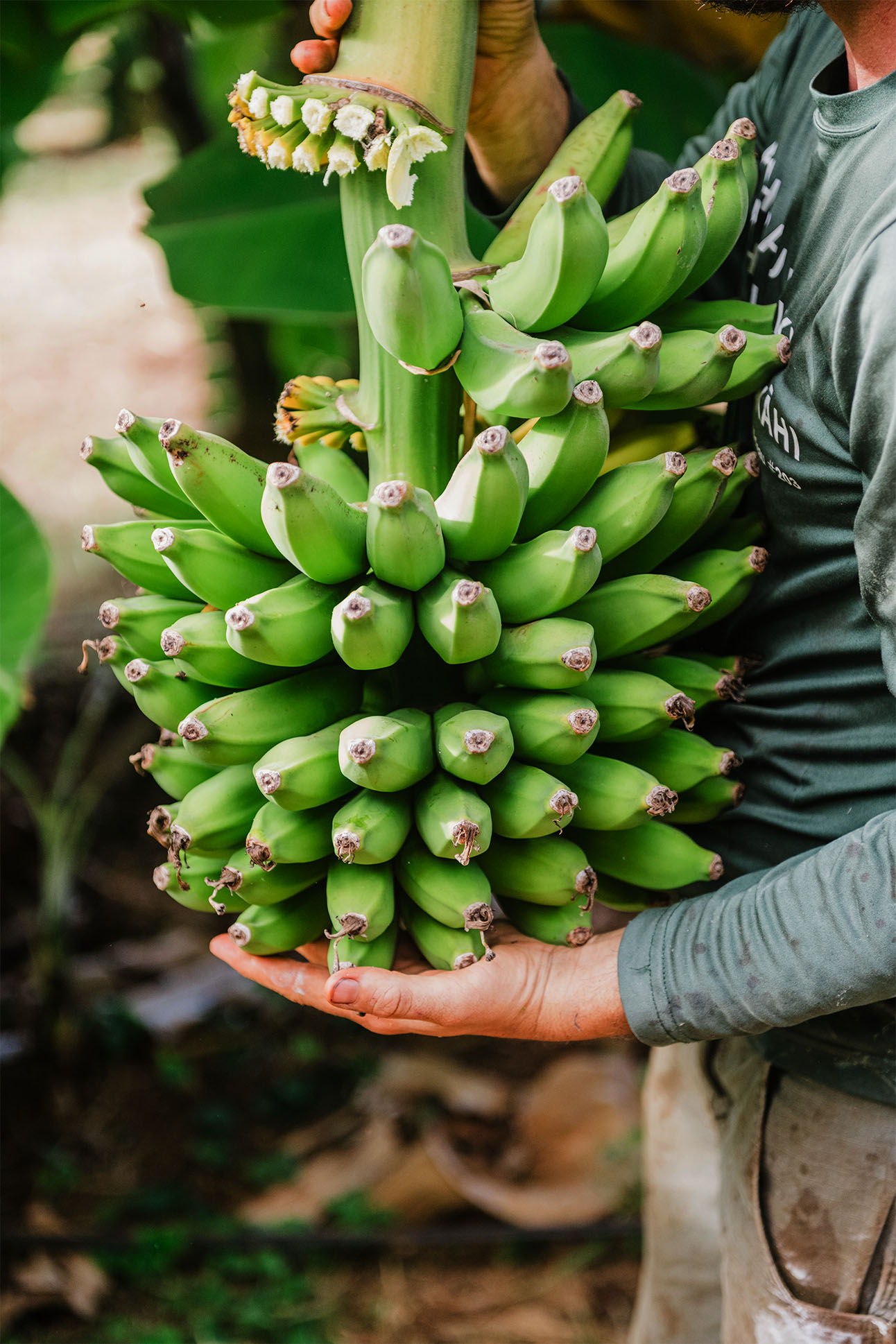
At 9:00 a.m., sun already radiating above, we strap on helmets, sunglasses, and seatbelts and conduct a radio check. Once the safety precautions are pau, we crank up our 4×4 ATVs and the adventure begins. “Our focus has never been about thrills,” asserted Keola Ryan, co-founder of North Shore Eco-Tours, hinting at the deeper focus of our impending excursion. “We want to have fun, but we also want it to be an educational experience.” A kumu hula and University of Hawai‘i instructor of Hawaiian Studies, Keola and his wife, Tasha Kawamata Ryan, who holds a Ph.D. in STEM education, began leading mauna tours and work days in 2012. To keep a light footprint, they keep groups to a max of 10 people and only lead them up twice a week. As an educational and cultural entity they present the ʻāina that these groups trek through a Hawaiian lens.
Beginning in ATVs or military trucks the couple leads groups past farmlands of all types. Kahuku Farms has mango, papaya, longan, and calamansi orchards, along with long rows of tuberose and pongamia beans, a possible new source for biofuel. Kō Hana Rum also grows sugarcane here. At the top of the Ko‘olau Mountain Range, about six miles from town, is the ʻŌpaeʻula Trail, named after an endemic red shrimp no longer found here, and is one of the trails created to access the old water system. The Ryans announce themselves and the group to the Kawailoa forest with an oli. When they feel a gentle breeze on their skin after a moment in silence, they lead the pack ahead. Throughout the hike Keola continues to model how to behave. He snacks on invasive strawberry guava, being mindful to not spit out the seeds and cause new growth. He clears the trail of invasive guinea grass with his machete and points out which plants to weed and which to let be — a tiny sprout of koa only four inches tall, for example. He stops frequently along the path to introduce the group to trees, plants, streams, and summits amidst 15,000 acres of conservation land, all by their Hawaiian place names.

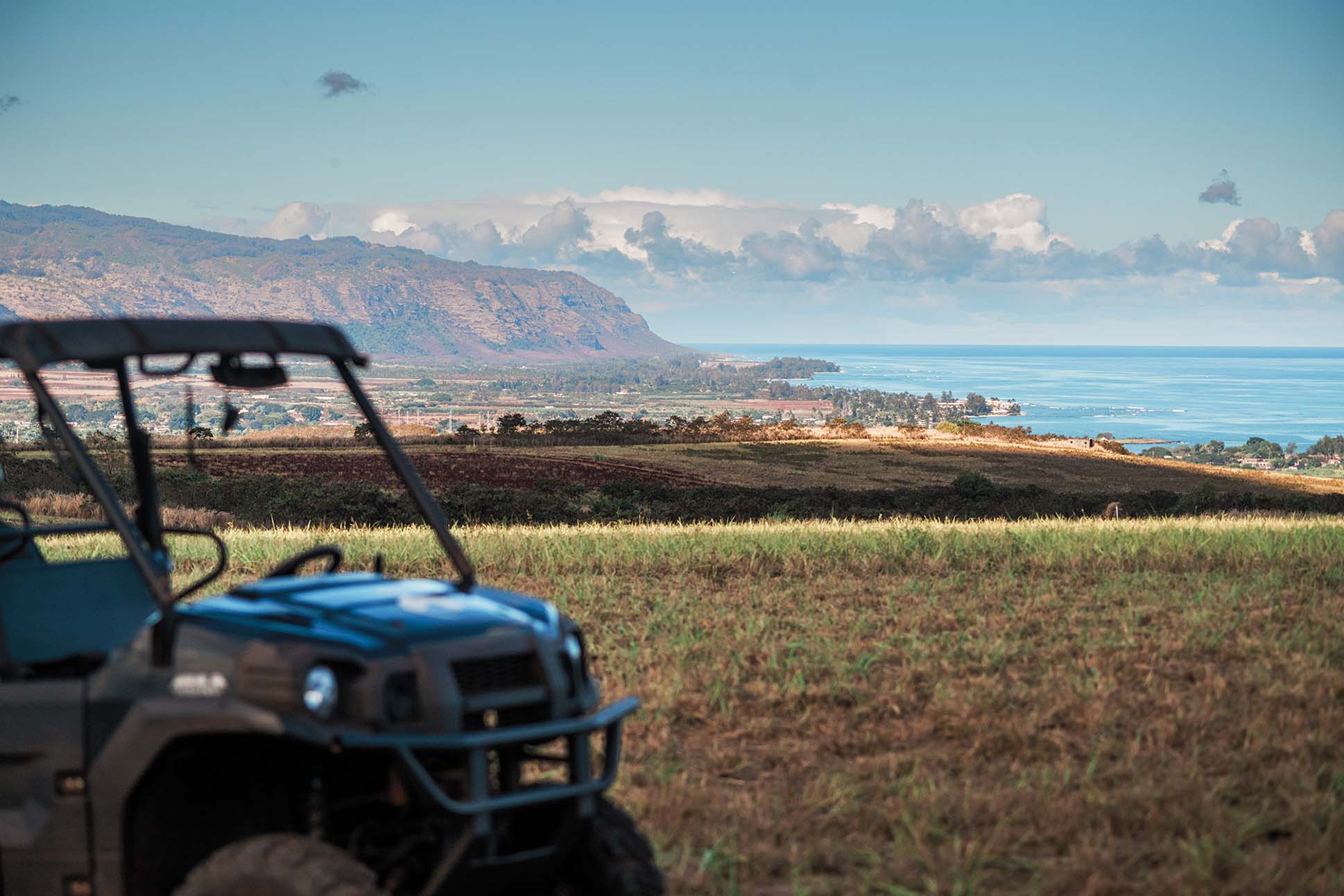


Cruising in atvs or military trucks, north shore eco-tours has an excursion that leads groups past farmlands of all types.
After crossing the ʻŌpaeʻula Stream, the couple stops at a freshwater pool for a light lunch, encouraging everyone to jump into the water to cool off. Relics of Waialua Sugar Company — its old cogs, telephone poles, and water pump — surround the banks. A house, built on Dole property just off Twin Bridge Road, hovers overhead. Base camp, a former Palama Settlement campground seven miles up the mountain, is where North Shore Eco-Tours stages and hosts workdays throughout the year. They consist mostly of university students, Boy Scouts, high school kids, and hālau hula in the lead up to the Merrie Monarch Festival as a quiet place for dancers to train. From this grassy knoll scattered with endemic ‘ōhi‘a and naupaka kuahiwi, one can see the Kawailoa ahupuaʻa and watershed. Kawai‘iki and Kawainui valleys merge here to form the Anahulu River system, once abundant with water and now eerily dry.
On the way back down we do a little off-roading in ATVs, where we plow through 10-foot high guinea grass as far as the eye can see. Along the way, drivers and passengers can hear their tour guides through loudspeakers. While the vantage point on the mauna gives visitors a sense of how abundant Waialua is, this sweeping view also serves as a reflection point. Occupying the spaces in between the last of the ‘iliahi and dwindling koa tree forests are 1,000 acres of Monsanto farmland, military helicopter landings, the tunnels and reservoir system built along the watershed by Waialua Sugar Company to divert water to sugarcane fields, and the ubiquitous Dole properties that seem to roll on for miles along Helemano Ridge. By the end of the tour, guests have had a well-rounded experience, seeing Oʻahu as more than just a place to live, work, and play, but as an island with a layered and complicated history. “They appreciate the place and islands much more afterward,” Ryan said.

